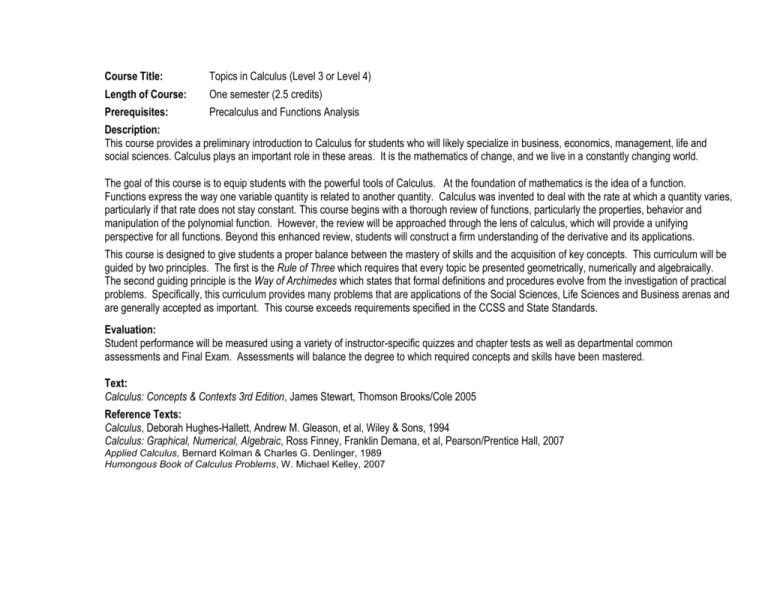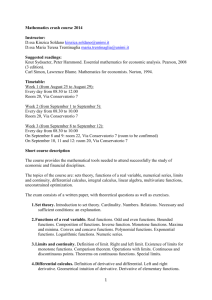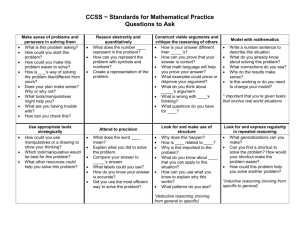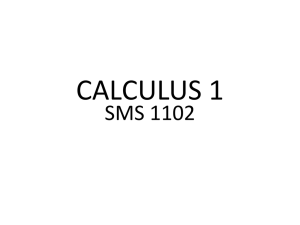
Course Title:
Topics in Calculus (Level 3 or Level 4)
Length of Course:
One semester (2.5 credits)
Prerequisites:
Precalculus and Functions Analysis
Description:
This course provides a preliminary introduction to Calculus for students who will likely specialize in business, economics, management, life and
social sciences. Calculus plays an important role in these areas. It is the mathematics of change, and we live in a constantly changing world.
The goal of this course is to equip students with the powerful tools of Calculus. At the foundation of mathematics is the idea of a function.
Functions express the way one variable quantity is related to another quantity. Calculus was invented to deal with the rate at which a quantity varies,
particularly if that rate does not stay constant. This course begins with a thorough review of functions, particularly the properties, behavior and
manipulation of the polynomial function. However, the review will be approached through the lens of calculus, which will provide a unifying
perspective for all functions. Beyond this enhanced review, students will construct a firm understanding of the derivative and its applications.
This course is designed to give students a proper balance between the mastery of skills and the acquisition of key concepts. This curriculum will be
guided by two principles. The first is the Rule of Three which requires that every topic be presented geometrically, numerically and algebraically.
The second guiding principle is the Way of Archimedes which states that formal definitions and procedures evolve from the investigation of practical
problems. Specifically, this curriculum provides many problems that are applications of the Social Sciences, Life Sciences and Business arenas and
are generally accepted as important. This course exceeds requirements specified in the CCSS and State Standards.
Evaluation:
Student performance will be measured using a variety of instructor-specific quizzes and chapter tests as well as departmental common
assessments and Final Exam. Assessments will balance the degree to which required concepts and skills have been mastered.
Text:
Calculus: Concepts & Contexts 3rd Edition, James Stewart, Thomson Brooks/Cole 2005
Reference Texts:
Calculus, Deborah Hughes-Hallett, Andrew M. Gleason, et al, Wiley & Sons, 1994
Calculus: Graphical, Numerical, Algebraic, Ross Finney, Franklin Demana, et al, Pearson/Prentice Hall, 2007
Applied Calculus, Bernard Kolman & Charles G. Denlinger, 1989
Humongous Book of Calculus Problems, W. Michael Kelley, 2007
Topics in Calculus
Learning Objective
Content Outline
Instructional Materials
Standards for Mathematical Practice
The student will…
1. Investigate the connection between
1. Evaluate and
how a function is defined with regard
interpret the limits of a
to the existence of a limit as x
function.
approaches some designated value.
2. Connect and identify the limit of a
function given its graph
3. Connect and identify the limit of a
function given its equation
4. Determine how and when a limit can
fail to exist.
5. Recognize and identify values at which
the limit of a function does not exist
Calculus: Concepts & Contexts
Sections 2.2- 2.3
District constructed materials
1. Make sense of problems and
persevere in solving them.
2. Reason abstractly and quantitatively.
3. Construct viable arguments and
critique the reasoning of others.
4. Model with math.
5. Use appropriate tools strategically.
6. Attend to precision.
7. Look for and make use of structure.
8. Look for and express regularity in
repeated reasoning.
6. Identify limits in a piecewise function
7. Sketch a function given information
about its limits
8. Use a graphing calculator to evaluate
limits of a function
9. Find limits using direct substitution and
factoring
August 2013
Page 2
Topics in Calculus
Learning Objective
Content Outline
Instructional Materials
Standards for Mathematical Practice
The student will…
2. Represent and
evaluate problems
involving continuity.
1. Investigate and identify where a function
is continuous given its graph or its
algebraic equation
2. Explain how and why the concept of
limits and continuity are related.
3. Sketch functions given information about
intervals of continuity
4. Investigate and identify values for
constants so that a piecewise function
will be continuous at a given point
Calculus: Concepts & Contexts
Section 2.4
District constructed materials
1. Make sense of problems and
persevere in solving them.
2. Reason abstractly and quantitatively.
3. Construct viable arguments and
critique the reasoning of others.
4. Model with math.
5. Use appropriate tools strategically.
6. Attend to precision.
7. Look for and make use of structure.
8. Look for and express regularity in
repeated reasoning.
5. Apply the Intermediate Value theorem to
functions and their graphs
August 2013
Page 3
Topics in Calculus
Learning Objective
Content Outline
Instructional Materials
Standards for Mathematical Practice
The student will…
3. Analyze the limits
involving infinity
graphically,
numerically,
algebraically, and in
context.
1.
Explain how and why the concept of limits
and horizontal asymptotes are related.
Explain how and why the concept of limits
and vertical asymptotes are related.
Calculus: Concepts & Contexts
Section 2.5
Identify infinite limits given the graph of a
function or the equation of a function
4. Identify limits at infinity given the graph of
a function or the equation of a function
5. Sketch the graph of a function given
information about infinite limits and limits
at infinity
6. Find a formula for a function given
horizontal and vertical asymptotes
District constructed materials
4. Represent and
relate problems
involving tangents,
velocities and other
rates of change
1. Find the slope of the secant line between
two points and apply that slope to a line
tangent to the curve at a specific point.
2. Find the slope of the tangent line drawn to
a curve at a given point using the limit
definition.
3. Find the equation of the tangent line
drawn to a curve at a given point and
interpret its meaning.
4. Explain how and why the concept of limits
Calculus: Concepts & Contexts
Section 2.6
2.
3.
and finding the slope of a tangent line to a
given curve are related.
http://www.calculus-help.com/tutorials
District constructed materials
1. Make sense of problems and
persevere in solving them.
2. Reason abstractly and quantitatively.
3. Construct viable arguments and
critique the reasoning of others.
4. Model with math.
5. Use appropriate tools strategically.
6. Attend to precision.
7. Look for and make use of structure.
8. Look for and express regularity in
repeated reasoning.
1. Make sense of problems and
persevere in solving them.
2. Reason abstractly and quantitatively.
3. Construct viable arguments and
critique the reasoning of others.
4. Model with math.
5. Use appropriate tools strategically.
6. Attend to precision.
7. Look for and make use of structure.
8. Look for and express regularity in
repeated reasoning.
5. Find the velocity of a moving particle at a
specific point given its position function
6. Sketch a graph of the position of a moving
particle given information about its velocity
and a starting point
August 2013
Page 4
Topics in Calculus
Learning Objective
Content Outline
Instructional Materials
Standards for Mathematical Practice
The student will…
5. Interpret and
represent the
derivative of a
function.
6. Analyze graphs of
function and its first
and second
derivatives and
distinguish
characteristics of
each.
August 2013
1. Model the geometric interpretation of a
derivative.
2. Evaluate the derivative of a function at a
given point and interpret its geometric
meaning.
3. Find the derivative (f ′ (c)) given the graph of
equation of the function (f(x))
1. Investigate and generalize the
relationship between the graph of f and f'.
2. Investigate and generalize the
relationship between the graph of f' and f""
Calculus: Concepts & Contexts
Section 2.7
http://www.calculus-help.com/tutorials
District constructed materials
Calculus: Concepts & Contexts
Section 2.8
3. Given the graph of a function estimate the
http://www.calculus-help.com/tutorials
derivative at various given points.
4. Given the graph of a function, create a
District constructed materials
sketch of its derivative function
5. Given an equation for a function (f(x)), find
the derivative (f ′ (x)) algebraically
6. Given a sketch of a function, identify where it
is not differentiable and why
7. Given a sketch of a function and its first and
second derivatives, distinguish between the
two graphs.
1. Make sense of problems and
persevere in solving them.
2. Reason abstractly and quantitatively.
3. Construct viable arguments and
critique the reasoning of others.
4. Model with math.
5. Use appropriate tools strategically.
6. Attend to precision.
7. Look for and make use of structure.
8. Look for and express regularity in
repeated reasoning.
1. Make sense of problems and persevere
in solving them.
2. Reason abstractly and quantitatively.
3. Construct viable arguments and critique
the reasoning of others.
4. Model with math.
5. Use appropriate tools strategically.
6. Attend to precision.
7. Look for and make use of structure.
8. Look for and express regularity in
repeated reasoning.
Page 5
Topics in Calculus
Learning Objective
Content Outline
Instructional Materials
Standards for Mathematical Practice
The student will…
7a. Connect and apply
the antiderivative to
the derivative
7b. Interpret graphs of
the derivative of a
function
1. Investigate how derivatives and
antiderivatives related to each other
graphically
2. Given the graph of a derivative function,
identify the places where the function is
increasing/decreasing, concave up/down,
local max/min, points of inflection
3. Sketch a graph of a function given
information about its derivative
4. Determine and explain whether or not
Calculus: Concepts & Contexts
Section 2.9
http://www.calculus-help.com/tutorials
District constructed materials
there is a one-to-one relationship
between derivatives and antiderivatives
1. Make sense of problems and persevere
in solving them.
2. Reason abstractly and quantitatively.
3. Construct viable arguments and critique
the reasoning of others.
4. Model with math.
5. Use appropriate tools strategically.
6. Attend to precision.
7. Look for and make use of structure.
8. Look for and express regularity in
repeated reasoning.
5. Sketch a graph of the antiderivative of a
given function
8. Represent and
evaluate problems
involving derivatives of
polynomials and
exponential functions
August 2013
1. Find derivatives of a constant function, a
power function, the product of a constant
and a function, a sum/difference of
functions and an exponential function.
2. Write the equation of the tangents and
normal lines to these functions at specific
points.
3. Find higher order derivatives.
Calculus: Concepts & Contexts
Section 3.1
http://www.calculus-help.com/tutorials
District constructed materials
1. Make sense of problems and persevere
in solving them.
2. Reason abstractly and quantitatively.
3. Construct viable arguments and critique
the reasoning of others.
4. Model with math.
5. Use appropriate tools strategically.
6. Attend to precision.
7. Look for and make use of structure.
8. Look for and express regularity in
repeated reasoning.
Page 6
Topics in Calculus
Learning Objective
Content Outline
Instructional Materials
Standards for Mathematical Practice
The student will…
9. Interpret and apply
the product and
quotient rules.
1. Determine and justify if the derivative
of the product of two functions equal to
the product of the derivative of each
function
2. Find derivatives functions that are the
Calculus: Concepts & Contexts
Section 3.2
District constructed materials
product/quotient of two differentiable
functions.
1. Interpret real applications, such as If
10. Apply rates of
f(t) represents the monthly revenue in
change to physics and
dollars and t is measured in months,
economics.
what is the meaning of f'(3) = 100?
2. Find and interpret the derivative given an
initial function.
August 2013
Calculus: Concepts & Contexts
Section 3.3
District constructed materials
1. Make sense of problems and persevere in
solving them.
2. Reason abstractly and quantitatively.
3. Construct viable arguments and critique the
reasoning of others.
4. Model with math.
5. Use appropriate tools strategically.
6. Attend to precision.
7. Look for and make use of structure.
8. Look for and express regularity in repeated
reasoning.
1. Make sense of problems and persevere in
solving them.
2. Reason abstractly and quantitatively.
3. Construct viable arguments and critique the
reasoning of others.
4. Model with math.
5. Use appropriate tools strategically.
6. Attend to precision.
7. Look for and make use of structure.
8. Look for and express regularity in repeated
reasoning.
Page 7
Topics in Calculus
Learning Objective
Content Outline
Instructional Materials
Standards for Mathematical Practice
The student will…
11. Investigate and
evaluate the derivative
of the sine and cosine
function.
1. Use the graphs of the sine and cosine
functions to prove their derivatives.
2. Evaluate the derivative of the sine and
cosine function at given points.
12. Apply the chain
1. Identify a complicated function as the
rule to find and
composition of two or more functions and
evaluate derivatives of
identify the order.
composite functions.
2. Analyze how and why the chain rule
works,
3. Implement the chain rule when asked to
find the derivative of a composite
function.
4. Relate and connect the chain rule to
appropriate functions.
5. Apply other methods of differentiation
when the chain rule is not necessary.
August 2013
Calculus: Concepts & Contexts
Section 3.4
District constructed materials
Calculus: Concepts & Contexts
Section 3.5
District constructed materials
1. Make sense of problems and persevere in
solving them.
2. Reason abstractly and quantitatively.
3. Construct viable arguments and critique the
reasoning of others.
4. Model with math.
5. Use appropriate tools strategically.
6. Attend to precision.
7. Look for and make use of structure.
8. Look for and express regularity in repeated
reasoning.
1. Make sense of problems and persevere in
solving them.
2. Reason abstractly and quantitatively.
3. Construct viable arguments and critique the
reasoning of others.
4. Model with math.
5. Use appropriate tools strategically.
6. Attend to precision.
7. Look for and make use of structure.
8. Look for and express regularity in repeated
reasoning.
Page 8
Topics in Calculus
Learning Objective
Content Outline
Instructional Materials
Standards for Mathematical Practice
The student will…
13. Implement implicit
differentiation.
1. Relate the chain rule to implicit
differentiation.
2. Distinguish functions expressed implicitly
and explicitly.
3. Initiate the use of implicit differentiation
when appropriate.
Calculus: Concepts & Contexts
Section 3.6
District constructed materials
14. Apply the derivative 1. Formulate a mathematical model of a
as a rate of change to
real world problem relating the given and
interpret real world
unknown rates of change.
problems.
2. Differentiate both sides of an equation
implicitly with respect to time.
3. Interpret a solution by translating the
mathematical result in context.
Calculus: Concepts & Contexts
Section 4.1
15. Connect and relate
the antiderivative to the
derivative.
Calculus: Concepts & Contexts
Section 4.9
August 2013
1. Find general antiderivatives and
determine if every function has a unique
antiderivative.
District constructed materials
District constructed materials
1. Make sense of problems and persevere in
solving them.
2. Reason abstractly and quantitatively.
3. Construct viable arguments and critique the
reasoning of others.
4. Model with math.
5. Use appropriate tools strategically.
6. Attend to precision.
7. Look for and make use of structure.
8. Look for and express regularity in repeated
reasoning.
1. Make sense of problems and persevere in
solving them.
2. Reason abstractly and quantitatively.
3. Construct viable arguments and critique the
reasoning of others.
4. Model with math.
5. Use appropriate tools strategically.
6. Attend to precision.
7. Look for and make use of structure.
8. Look for and express regularity in repeated
reasoning.
1. Make sense of problems and persevere in
solving them.
2. Reason abstractly and quantitatively.
3. Construct viable arguments and critique the
reasoning of others.
4. Model with math.
5. Use appropriate tools strategically.
6. Attend to precision.
7. Look for and make use of structure.
8. Look for and express regularity in repeated
reasoning.
Page 9
Topics in Calculus
Recommended Unit Sequencing and Pacing Guide
Timeframe
Topics
Q3
Limits & Derivatives
The Tangent & Velocity Problems (2.1)
The Limit of a Function (2.2)
Continuity (2.4)
Limits Involving Infinity (2.5)
Tangents, Velocity and Other Rates of Change (2.6)
Derivatives (2.7)
The Derivative As A Function (2.8)
What Does f ′ Say About f? (2.9)
Q3
Differentiation Rules
Derivatives of Polynomial & Exponential Functions (3.1)
The Product & Quotient Rules (3.2)
Rates of Change in Physics and Economics (3.3)
Derivatives of Sine and Cosine Functions (3.4)
The Chain Rule (3.5)
Implicit Differentiation (3.6)
Q4
Applications of Differentiation
Related Rates (4.1)
Maximum & Minimum Values (4.2)
Derivatives & The Shape of Curves of Polynomials (4.3)
Graphing With Calculus & Calculators (4.4)
Optimization Problems (4.6)
Antiderivatives (4.9)
Final Exam
August 2013
Page 10








